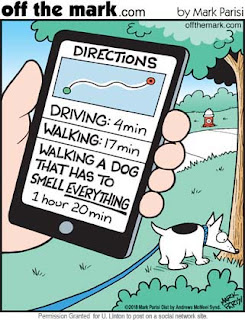Why is all this important to those of us who live with dogs and are responsible for their care? It is because when we know these priorities of our dogs, we can best ensure their well-being by fulfilling these canine needs.
Dogs need to sniff!
As well as being fulfilling, processing scents is mentally tiring too so this can help with the calmness of your dog when they return home after a walk.
It is a good sign if your dog is walking along in a relaxed way, engaging with their environment by stopping to sniff the interesting scents along the way.If your dog rushes along in a hyperactive way, taking little or no time to sniff then yes, they might be excited, but lack of time taken to sniff could be a sign that this excitement is tinged with anxiety too. Perhaps that particular walk is too much for them mentally. Maybe there are a lot of other people and other dogs and this is causing your dog concern.
As with dogs who react dramatically out of fear when they see others, if possible, walking somewhere quieter might allow these dogs the chance to relax and do some enjoyable sniffing.
A dog-friendly way of walking
Perhaps you already know about the importance to your dog of getting to sniff on walks. If so, your dog is very lucky!
If the idea is new to you, or something you never thought much about before, maybe you could try to allow your dog's sniffing to become a big part of the walks you enjoy together.
But what about all the hanging about while your dog is engrossed in sniffing a clump of grass?
When you just 'be in the moment' with your dog, enjoying watching them doing something that they love and something that is vital to them, then it becomes a lovely experience for you too.
Ursula Linton



Awesome! That last comic is definitely me. I used to feel self-conscious just standing around while my dog sniffed but now it feels totally normal and I have no idea if I look strange or not haha.
ReplyDeleteIt's wonderful that you do that! Your dog is very lucky and will appreciate it beyond measure.
ReplyDeleteThank you so much for your lovely comment.
Best wishes
Ursula